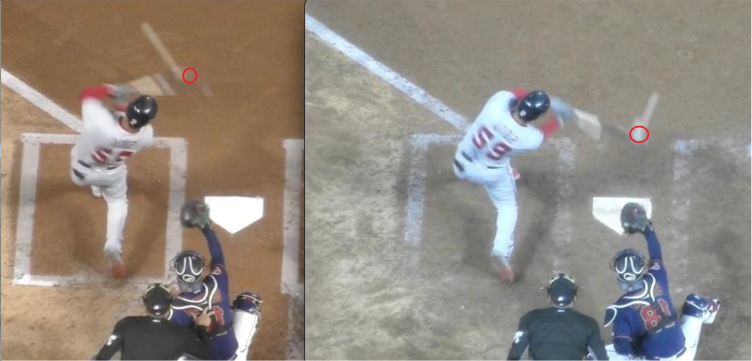
Spatial Memory and Bat Orientation: Synaptic Connections for Intertwined Memories
By Ken Cherryhomes
The creation of a memory that links spatial information with the orientation of the hands and the bat is a critical aspect of successful hitting in baseball.
The memory that binds spatial predictions, contact depth memory, and the arc orientation of the bat is a central aspect of intentional ball placement in baseball hitting. This memory forms through consistent observations of the pitch’s trajectory while considering the batter’s position and pitch location.
A key element that often remains unnoticed is the arc traced by the bat’s barrel—a circular motion in response to pitch characteristics and the batter’s anticipation.
In subsequent plate appearances, this memory resurfaces, playing a dual role. It not only anticipates the pitch but also guides the arc of the bat. This orchestrated interplay aligns spatial cues with the bat’s orientation, all while accounting for contact depth, resulting in precise ball placement.
Memory weaves these components together. These memories intricately unite the spatial prediction of the pitch, the proprioceptive feedback about the bat’s position, and the nuanced arc orientation. Over time, these memories deepen, refining the interaction between spatial predictions, proprioceptive awareness, and angular adjustments.
In this context, the batter’s brain creates a memory that associates the timing of when to swing with the spatial position of the pitch. This memory forms through repeated experiences of seeing and tracking the ball’s trajectory as it approaches the plate. As the brain processes this visual information, it also takes into account the batter’s own body position and the pitch’s location.
The orientation of the hands and the barrel of the bat comes into play as the batter makes contact with the ball. This orientation determines the angle at which the bat meets the ball, which in turn affects the direction and trajectory of the hit. The brain stores this spatial and kinesthetic information in the memory, creating a link between the visual cues of the pitch, the timing of the swing, and the resulting orientation of the bat.
As the batter gains experience and practices consistently, this memory becomes more refined and accurate. The brain develops a better understanding of how to adjust the orientation of the hands and the bat based on the pitch’s trajectory, speed, and location. This is why professional baseball players often have the ability to make split-second adjustments to their swings.
The memory formation described involves the integration of spatial information, timing, and kinesthetic feedback. This memory guides a batter’s ability to anticipate and adjust their swing based on the pitch’s characteristics, leading to effective hitting outcomes.
The intricacies of how baseball batters process proprioceptive information and integrate it with their understanding of the bat’s orientation are truly fascinating. The way players adjust their swing’s timing based on the pitch’s trajectory and speed, while also considering the alignment of the bat’s barrel to the depth of bat ball contact, is a testament to the complexity of the skill involved in hitting.
The fact that batters are able to internalize these subtle details and make split-second adjustments reflects the high level of proprioceptive awareness that skilled players develop over years of practice. Their brains create precise maps of the bat’s position in relation to their body and the incoming pitch. This information is then used to finely tune the orientation of the hands and the barrel of the bat to optimize their chances of making solid contact.
This level of proprioceptive accuracy showcases the depth of sensory integration that baseball hitters cultivate. It’s a remarkable example of how the brain processes and utilizes sensory information to execute complex motor tasks with remarkable precision.
Let’s dive deeper into the intricate interplay between spatial predictions, proprioceptive awareness, and the creation of memories that tie these elements together in the context of baseball hitting.
- Spatial Predictions and Pitch Trajectory: Skilled batters develop the ability to predict the trajectory of an incoming pitch. This prediction involves analyzing the pitch’s initial speed, angle, and trajectory from the pitcher’s hand. The brain rapidly processes this visual information and generates an estimation of where the ball will cross the plate, allowing the batter to prepare for the swing.
- Proprioceptive Feedback and Bat Orientation: As the pitch progresses towards the batter, proprioceptive receptors in the hands, wrists, and arms provide continuous feedback about their position and movement. This feedback helps the batter maintain an optimal bat orientation, adjusting the angle of the hands and barrel to align with the predicted path of the ball.
- Angular Positioning of the Barrel: Based on the proprioceptive feedback and the spatial prediction, the batter calculates the optimal angle at which to intercept the ball. This involves adjusting the angular positioning of the barrel to ensure that the bat will meet the ball at a desirable contact point and angle. The brain creates a dynamic mental model of the bat’s position relative to the incoming ball, continuously updating this model as the pitch progresses.
- Memory Formation: Successful hits result in the creation of memories that integrate all these elements. The brain links the spatial prediction of the pitch’s trajectory, the proprioceptive feedback indicating the position of the bat, and the angular adjustment of the barrel to a positive outcome (e.g., a solid hit). These memories are stored and can be retrieved in subsequent at-bats, contributing to the batter’s ability to replicate successful swings.
- Iterative Learning: Over time, as batters face a variety of pitches and situations, their brains refine these memories. With each successful swing, the brain is learning, further honing the relationship between spatial predictions, proprioceptive awareness, and angular adjustments. This iterative learning process leads to the development of a finely-tuned neural circuitry that guides hitting performance.
In summary, this process involves a sophisticated integration of spatial predictions, proprioceptive feedback, and motor adjustments. The brain creates memories that tie together these elements, allowing batters to adapt their swings to match the pitch’s location, speed, and trajectory. This integration of sensory input and motor output showcases the remarkable computational capabilities of the brain and the intricate learning that takes place over a baseball player’s career.
Please send questions and comments to:
